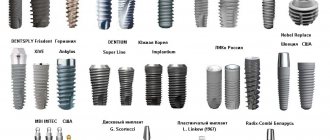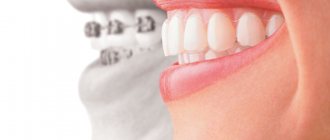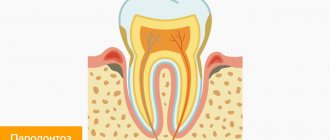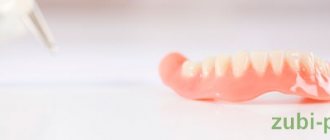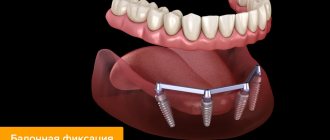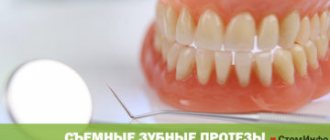We will describe in detail which crowns are best to place on chewing teeth and which on the front teeth. Our specialists have been installing the best crowns at affordable prices for over 25 years.
Many patients, before visiting a specialist, study the types of dental crowns and seek to find out which ones are best suited for each specific situation. Most people rely on forums, others ask their friends questions about the results of prosthetics. Unfortunately, only a few manage to obtain real information.
This article provides comprehensive information regarding the different types of crowns, methods of their manufacture, performance characteristics, service life and pricing policy. We hope that while reading this material you will study in detail the types of crowns on teeth and be able to understand which ones are best suited for a particular area of the jaw.
For everyone who does not know where it is best to put crowns on their teeth , we offer services of the highest level. In our clinic, all procedures are carried out under the guidance of specialists with impressive experience and deep knowledge in the field of prosthetics. In addition, we focus on using only modern durable materials, high-precision dental equipment, and implement effective technological solutions. This allows each patient to count on high-quality and long-lasting treatment results.
Types of the best dental crowns for 2020
Modern dentistry offers patients crowns made from various materials. It is this indicator that is key in determining the cost, quality parameters and indications for the use of a particular prosthesis. Another important criterion on which the quality of a product depends is the production method.
The following crowns are currently in demand:
- Metal-ceramic. They are among the most popular prosthetic devices. Includes a metal base and an outer facing layer of ceramics. Initially, the frame is made, after which the ceramic coating is performed. The production process can be carried out on the basis of modern computer programs and aesthetic modeling.
- All-ceramic. In the manufacture of such prostheses, metal-free ceramics are used. Provides maximum safety in relation to soft tissues, which is due to the biological inertness of this material. The manufacturing process is based on the firing technique; ceramic pressing technologies; use of milling equipment and modern digital programs.
- Crowns made of zirconium material. Despite its origin (metal), zirconium dioxide is famous for its unrivaled aesthetics and increased safety. The manufacturing process is based on the use of specialized digital programs and milling equipment. Two versions of such prostheses can be used: combined (include a base of zirconium material and ceramic lining) and monolithic (made of zirconium oxide without the use of a ceramic coating).
- Glass ceramics e.max. It is distinguished by perfect aesthetic parameters and the necessary strength. There are currently 2 material options in use: E.max RPESS - produced by injection molding using elevated pressure and temperature conditions, and E-max CAD - produced using modern digital applications and milling machines (CAD/CAM concept).
Comparative characteristics of the best crowns
To determine which crowns are the best , you need to study the pros and cons of each product, taking into account the material used.
Next, we will compare the key parameters of various prosthetic options:
| Crown | pros | Minuses |
| Made from metal-ceramics using precious metals | Has increased strength, has a natural appearance, does not cause allergization of the body | High price |
| Made from metal-ceramics using non-precious metals | It is famous for its sufficient strength, has a reasonable price and good aesthetic parameters | There is a possibility of allergy |
| Made of ceramic material | Features impeccable aesthetic parameters and absolute compatibility with the patient’s body | Increased fragility |
| Made of zirconium material | Excellent aesthetic properties, long period of operation, absolute compatibility with the body, absence of allergic reactions | Impressive value |
| e.max crowns | Unsurpassed aesthetics, increased strength, excellent light transmittance. Emax Press has a gradient of color and transparency. | High price. Only single crowns can be installed in the chewing region. |
What are the best crowns for chewing teeth?
In general, the controversial issue regarding which crown is best to place on chewing teeth may have a completely unambiguous solution. Since this department experiences increased chewing pressure, it is advisable to use high-strength and most reliable prostheses to recreate the missing units. However, despite the need to restore functional characteristics in this area, the aesthetic component should not be ignored. Moreover, making the right choice is also important from the standpoint of the biocompatibility of the material.
Next, you will get acquainted with detailed information regarding which crown is best to place on the chewing teeth, taking into account the material used:
- Metal ceramics . According to statistics, this material is among the most popular in orthopedic practice. First of all, this is due to the excellent quality and affordable prices for such crowns. As for the negative aspects, they include a significant likelihood of chipping, unlike traditional analogues. In addition, there is a risk of cyanosis appearing at the border of the gum and the prosthetic device, which has an undesirable effect on aesthetics;
- Dentures made of ceramic material . The possibility of using such crowns depends on their type. It is undesirable to fix standard ceramic structures in the masticatory region due to their significant fragility and increased likelihood of breakage. However, at the moment it has been possible to develop more durable crowns that make it possible to recreate the missing units in any area of the jaw. These include Emax and Empress glass-ceramic structures. But if you study dental crowns from the point of view of which ones are better, the price in this case is not a priority criterion (over 20,000 rubles per unit);
- Structures made of zirconium material . They allow you to recreate the missing units in the lateral section, since they are considered the most highly durable and durable prostheses. It is recommended to use monolithic crowns, which eliminates the possibility of using a porcelain coating and, as a result, minimizes the possibility of chipping. However, the price of such a prosthetic device can be higher than 30 thousand rubles;
- Emax crowns . Despite the exceptional aesthetics and excellent strength parameters (up to 400 MPa), such crowns are best used for the frontal area. For the chewing region, it is allowed to use single crowns made of E-max RPESS material obtained by pressing.
Types of fillings
They can be conditionally divided according to the material of manufacture and purpose. So, it is customary to distinguish the following types:
Temporary fillings
They are used as a filling at intermediate stages of dental treatment. For example, during the treatment of apical periodontitis, when it is necessary to check the sealing. They are also irreplaceable in the treatment of pulpitis using the devital method, when a medicinal substance is placed under the pad.
This material can be easily removed if necessary. It has low strength but sufficient adhesion to temporarily cover the problem area. Its composition is absolutely harmless if swallowed by the patient.
Cement fillings
Cement fillings.
Advantages - due to stickiness and the possession of certain chemical properties, they find their application. Disadvantages: poor aesthetics and wear and tear over time. This type of filling has been used for quite a long time, but today it has not lost its relevance. There are three types of materials used:
- Silicate . They contain special glass and phosphoric acids. After polymerization, silicates are capable of releasing fluorine to a certain extent. Therefore, they are quite relevant for acute caries. However, they are not used in primary occlusion due to the fairly large release of orthophosphoric acid. Weak enamel can become saturated with this substance and a chemical burn of the pulp will occur.
- Phosphate . These are low-quality products that dentists are gradually abandoning. For a long time they were used as insulating pads in the treatment of uncomplicated caries. Until now, phosphate cements are used under the crown during dental prosthetics.
- Glass ionomer . They have a chemical composition very similar to natural tooth tissue. Thanks to this they have excellent adhesion. Polymerization occurs under the influence of ultraviolet radiation. The doctor manages to completely shape the material to the anatomical shape of the tooth. Glass ionomers have some modifications that are characterized by increased strength. So they include ceramics or even metal. This property allows them to be successfully placed on chewing teeth. Glass ionomer cements have been successfully used in primary dentition. They release a large amount of fluoride, at the same time, without having a toxic effect on the pulp. A high degree of adhesion allows you to place a filling even in a humid environment. Unfortunately, they lack aesthetics. But modern dentistry is already producing glass ionomers to which photo-curing is added, which makes it possible to achieve fairly high aesthetic results.
Composite fillings
Composite fillings are made of hard plastic, making them very safe and strong.
The main advantage is the color that matches the teeth, but the disadvantage is the short service life (5 years). These are relatively new technologies in the treatment of complicated and uncomplicated dental caries. But in a short period of use, they have already earned the trust of many patients and dentists. This type of material also has its own subgroups, which mainly include the following:
- Acrylic oxide compounds . They are one of the first composite compounds. They have sufficient strength and abrasion resistance. However, they have more negative qualities than positive ones. The main disadvantage is high toxicity. They are categorically not recommended to be placed on non-pulpless teeth. There are cases where acrylic-containing materials had a toxic effect on neighboring healthy teeth and contributed to the development of caries. At the same time, they are successfully used in pulpless chewing teeth. The service life of the material is up to 5 years.
- Epoxy compounds . Made on the basis of epoxy resins. They are stronger than acrylic fillings, but are quite fragile. In addition, they darken after a few years. Epoxides are less toxic. When placed, they perfectly fill the cavity and are evenly distributed. Their rapid hardening can prevent the dentist from forming a filling in a timely manner. The service life of the material, like acrylic, is up to 5 years.
A product made from the materials listed above is a so-called chemical filling. That is, its hardening occurs on its own due to certain processes occurring by composition and contact with the environment. Other representatives of composites are compounds that harden only under the influence of a special lamp.
- Light-curing fillings . They are a high-quality material in terms of aesthetic and physical properties. They are successfully placed both in the chewing and in the frontal areas of the jaw. For the best contrast, match the color to the tooth tissue. The package can contain up to 12 tubes with different color markings. Polymerization occurs only from exposure to an ultraviolet lamp, and then only by 70-80%. To impart strength, the surface of the filling must be carefully ground and finely polished after hardening.
The service life of composites is from 5 to 10 years. In modern dentistry, the use of hybrid composites and nanocomposites is practiced. These compounds contain very small particles. Namely, they provide ultra-reliable adhesion to natural fabrics. This is the best option for treating chewing teeth. However, dentists tend to consider the material universal and use it in all cases.
Compomer compounds (compomers)
Compomer fillings are a combination of glass ionomer and composite materials.
They incorporate the reliable fixation of the former and the aesthetic characteristics of the latter. But they also inherited disadvantages, so they usually wear out faster than even composite ones. The first compomer fillings began to be used in the early 1990s, representing a hybrid of composites and glass ionomers. Both types of these materials have both positive and some negative properties.
Their complex composition includes benzoin and amine peroxides, monomer, various resins and polyacrylic acid. Polymerization occurs evenly, without the formation of pores, which gives the filling additional strength. This light filling is placed mainly on the fangs and incisors, that is, in the places of the least load. However, it has been practically proven that compomers are able to withstand any chewing load. An important disadvantage is the rather high price and fragility, like composite materials.
Filling materials for baby teeth
Colored fillings for children are made of composite materials.
But instead of having a specialist select the natural tooth color, the child is left to choose the color. The main thing here is the psychological factor. The short service life of such a filling is usually quite sufficient for a baby tooth. For a long time, dentists were content with only glass ionomer cements. But they did not quite meet all the requirements. Today it is proposed to carry out fillings with special children's colored materials based on composite resins. This very unusual approach has recently been used and has gained popularity among children and dentists. In addition to their color appearance, these products have a number of advantages over conventional fillings:
- They combine the properties of glass ionomers and photopolymers.
- They have high plasticity, which allows the dentist to easily work with them and achieve the best placement in the carious cavity.
- They have a high degree of adhesion to milk tissue.
- It is installed on baby teeth and is kept on them for up to 3-4 years. This is quite enough for the normal process of changing the bite to take place.
- The material is capable of accumulating fluoride from toothpaste and food during chewing.
- On bright fillings, areas of abrasion are more noticeable, which can be corrected in a timely manner.
- Affordable price.
- Psychological factor. From the first visit to the dentist, the child begins to show interest in colored fillings. Thanks to this, tension is relieved during treatment, and the habit of oral care is quickly instilled. The child is happy to visit the dentist again.
Amalgam fillings
Amalgam or “silver” fillings have been the most popular and effective filling in dentistry for the past 150 years.
Advantages: durability, affordability, and installation in one visit. Disadvantages - unaesthetic, sometimes it is necessary to remove healthy tooth tissue for installation in order to make room for filling, over time it can fade or crack due to temperature changes. Such fillings are also called silver fillings. This is outdated material. It is an alloy of mercury, silver, tin or copper. The filling is very hard, durable, but completely lacks aesthetic qualities. There is evidence that the material lasted in the oral cavity for more than 20 years.
The big disadvantage is the high thermal conductivity and heat capacity. In addition, there are suggestions that mercury particles may be released from the amalgam. As you know, this is a very harmful substance that can cause some mutations and cancer in the body. But this fact remains unproven and it is believed that the amount entering the body is extremely insignificant. At the moment, amalgam is practically not used.
The choice of one or another filling material remains with the patient. The doctor can only recommend which one to choose after an adequate examination and diagnosis. The patient has the right to refuse the imposed material, but he must consider the consequences of his choice. If you ask a doctor, he can always tell you about the advantages and disadvantages of a particular material, so only the dentist knows which filling is better.
zdorovko.info
1. These Rules govern the relationship between Argumenty i Fakty CJSC (hereinafter referred to as the Publication) and the person (hereinafter referred to as the User) who provided the publication with photos and video materials (hereinafter referred to as the Materials). 2. The transfer of Materials to the Publication and their placement on the website aif.ru (hereinafter referred to as the Site) becomes possible for the User after expressing agreement with the terms of these Rules and filling out the items in a special form. 3. By providing copies of the Materials to the Publication, each User thereby: 1. guarantees that he is the author of the Materials and the owner of the exclusive right to them, confirms that the rights to use the Materials, including the rights to reproduction, distribution, public display, broadcast on the pages of the Publication in social networks, messages broadcast and via cable, made available to the public, are not transferred to third parties. 2. gives full and irrevocable consent to the posting of Materials on the Site; 3. agrees that he bears full responsibility in relation to the Materials posted on the Site; 4. refuses any types of royalties for the use of Materials by the Publication in accordance with these Rules. 4. The user bears responsibility under Russian legislation for violation of intellectual rights of third parties. 5. The user confirms his consent to the processing of his personal data provided by the Publication. The processing of the User's personal data is carried out in accordance with the legislation of the Russian Federation. The publication guarantees the confidentiality of information provided by the User. This information is not subject to disclosure to third parties, except in cases provided for by the current legislation of the Russian Federation. 6. In the event that third parties make any claims against the Publication related to the placement of Materials on the Site, as well as the use by the Publication of Materials provided in accordance with these Rules, the User undertakes, on his own and at his own expense, to settle these claims with third parties, and the Publication reserves the right to withdraw Materials from public access until such settlement. 7. The publication is not responsible for the content of the Materials and for their compliance with the requirements of the legislation of the Russian Federation, for violation of copyrights, the use of trademarks, company names and their logos, as well as for possible violations of the rights of third parties in connection with the placement of Materials on the Site. 8. Materials must not contain any illegal elements, help incite religious, racial or ethnic hatred, contain scenes of violence or inhumane treatment of animals, be obscene or offensive in nature, contain advertising of drugs, violate the rights of minors, be pornographic in nature, contain commercial advertising in any form, as well as damage the honor, dignity and business reputation of third parties. 9. When posting Materials, the Publication indicates the name of the User specified by the User when providing the Materials. 10. The publication has the right to refuse to post Materials without explaining the reasons for the refusal, and also to remove Materials at its discretion if their content contradicts the norms of ethics and morality, does not meet the requirements established by the legislation of the Russian Federation, and contradicts the requirements of these Rules. 11. The publication is not responsible for the complete or partial loss of Materials provided by the User. 12. These Rules may be changed by the Publication unilaterally without special notice to the User.
www.aif.ru
An alternative to crowns for chewing teeth
It should be remembered that even in the presence of significant damage, a tooth can be restored using a conventional light-composite filling and pin. If it is necessary to eliminate a single defect, implant fixation is recommended.
Which is preferable: a filling, a pin or a crown?
As mentioned earlier, with significant destruction of the coronal part of the tooth (more than 50%), it is possible to recreate it using a light-composite filling mass. In this case, a pin made of fiberglass or metal material is used, which allows for more reliable fixation of such a filling.
If the tooth crown is destroyed by more than 50%, experts recommend resorting to the use of a prosthesis. This primarily applies to units from which the pulp has been removed, as these are considered the most fragile.
Also, in case of significant destruction of the coronal part, dentists use a special stump insert, which ensures a more durable installation of the prosthesis.
What to choose: a crown or a dental implant?
When considering the replacement of missing units with crowns, implant fixation is the preferred option for eliminating a single defect. When using a dental structure, the need to prepare teeth that act as supporting elements is eliminated. In addition, implants have a longer period of use, in contrast to single prosthetic structures and bridges.
How to decide on the type of filling
Having studied the basic information about the types of fillings, it will be easier for you to make a choice. There are basic requirements for the material, after reading which you can make the right choice and determine whether the dentist performed the treatment efficiently:
- The surface of a filled tooth cannot be perfectly smooth, since a real tooth has irregularities and tubercles that ensure effective chewing of food.
- The tooth cavity must be completely filled with filling material without air gaps through which infection can penetrate.
- If the filling is located on top, it should not come into contact with neighboring teeth.
- A good filling does not hang from the tooth, creating conditions for plaque to accumulate.
- To avoid premature wear, the dentist covers the filling with a special material that fills any remaining microvoids.
- Please note that if the doctor has selected the material correctly, you should not feel pain after installation. Otherwise, the dentist did his work in bad faith.
What are the best crowns for front teeth?
When we are trying to figure out how to choose the best crowns for the front teeth, the priority criterion is the aesthetic component. At the same time, prosthetic structures intended for the frontal region must have a natural appearance, fully correspond to natural analogues and have sufficient strength. However, when you plan to fix a crown on the front teeth, there is no point in asking: “Which dentures are better to install on the lower jaw, and which ones on the opposite side?”
In both cases, the same type of prosthetic device models are used. Below we will provide more selected information:
- Metal-ceramic crowns . Despite the reasonable cost, this is not a completely suitable option in terms of aesthetic parameters. Firstly, an undesirable bluish tint appears in the area where the prosthesis adheres to the gum. Secondly, the metal base can be viewed through the ceramic coating. Of course, today there are improved designs with shoulder mass, but their price will significantly exceed the cost of a standard crown;
- Dentures made of ceramic material . This is the most advantageous option in cases where a dilemma arises as to which crowns are best placed in the frontal part of the jaw. Moreover, for this department you can resort to the help of traditional prostheses made of all-ceramic material. Their cost is considered affordable for most patients;
- Zirconium crowns . This solution is considered one of the most expensive when it is necessary to reproduce anterior teeth. However, this option is considered preferable for those who want to find out which crowns are best to put on their front teeth, but for whom pricing policy does not matter;
- Emax crowns . Such designs are made from an improved material - glass ceramics, which has excellent aesthetics. In this case, it is advisable to choose the E-max RPESS Multi material, which has a gradient of color and transparency, which will allow you to recreate the lost frontal units with maximum identity.
Our clinics
Clinic "Elident" on Varshavskaya
Varshavskoe highway, 75, bldg. 1, Moscow 117556
- Varshavskaya (500 m, closed until 2021)
- Nakhimovsky Prospekt (1,300 m)
Mon-Sat : 09:00-21:00; Sun : 09:00-19:00.
Online registration
+7 (495) 411-93-63
Elident Clinic in Annino
Varshavskoe highway, 154, building 1, Moscow 117405
- Annino (500 m)
- Academician Yangelya (700 m)
Mon-Sat : 09:00-21:00; Sun : 09:00-19:00.
Online registration
+7 (495) 411-93-63
Alternative options to frontal crowns
At the moment, there are three alternative methods that allow you to restore the crown part of the tooth, with destruction of no more than 50%. These include:
- Veneers. Suitable for use if there is slight destruction of the outer surface of one of the front teeth. An important requirement for carrying out a procedure using such plates is the preservation of the tooth wall from the inside. Through veneers, unsurpassed aesthetics are achieved, the possibility of tooth preservation is ensured and it is possible to significantly extend the life of the tooth;
- Dental implants. If it is necessary to reconstruct 1-2 teeth and install bridge-like prosthetic devices, it is advisable to fix the implants instead of preparing the supporting units;
- Filling material. As mentioned earlier, the option with light-composite restorations is preferable when the coronal part of the tooth is destroyed by no more than 50%.
Types of filling materials
The choice of material for filling a tooth depends on what the patient needs.
Some will require a more durable material, while others will prioritize aesthetics.
When restoring front teeth, it is not recommended to save money, and it is better to immediately put a high-quality filling, and when treating lateral teeth, cheaper options may be suitable.
When choosing a material for a filling, it is necessary to remember that, for example, cements wear off and dissolve over time due to the action of saliva. Their service life on average is no more than 3 years.
Filling materials must be:
- Resistant to saliva.
- Resistant to changes in original color.
- Fast to harden.
- Durable and solid.
- Harmless.
What crowns are best to put on implants?
When studying the question of which crowns are best placed on implants, one should remember the classic procedure for installing dentures. If it is necessary to recreate the missing units in the frontal region, experts give preference to the aesthetic component. The best dental crowns in this situation will be made from zirconium material or ceramic.
If you need to fix crowns on your chewing teeth, and you don’t know which ones are better, any experienced dentist will give clear advice - in this area it is advisable to install prosthetic devices made of metal ceramics, zirconium material or e.max glass ceramics. It should also be taken into account that adapters in dental structures, in the event of subsequent use of the above prostheses, must be obtained from materials that are unable to be seen through the ceramic layer.
Many patients are interested in which crowns are better, ceramic or zirconium, to be fixed to implants? According to leading experts, the most advantageous options include devices made from the innovative material E-max or zirconium dioxide.
Additionally, when evaluating whether metal-ceramic or zirconia crowns are better, it is important to consider the need for zirconia adapters. This will prevent the body from becoming allergic to metal, as well as obtain the desired aesthetic result.
Prices for tooth crowns at Elident
When assessing dental crowns from the standpoint of which ones are better financially, one should take into account the material used, the technological solutions being implemented, the equipment used, as well as the level of professionalism of the specialist and the rating of the dental institution in which the teeth are restored.
The Elident clinic has affordable prices for all types of services related to the fixation of implants and the installation of dental crowns. At the same time, you can always count on an individual attitude and high professional training of dentists, which is combined with the use of highly effective innovative equipment and modern prosthetic concepts.
| Service | Price, ₽. |
| Consultation with an orthopedist | for free |
| Orthopantomogram - panoramic image of teeth | 950 |
| Metal-ceramic crown Degussa M with shoulder mass (Germany) | 10 500 |
| Ceramic crown Dutseram plus (Germany) | 20 500 |
| Solid crown | 5 500 |
| Ceramic crown made of zirconium dioxide | 32 000 23 000 |
| Empress crown | 19 000 |
| Metal-ceramic crown on an implant | 18 500 |
| Ceramic crown made of zirconium dioxide on an implant | 35 000 |
| Metal-ceramic crown on zirconium dioxide for Straumann implant (SPECIAL!!!) | 35 000 26 500 |
| Metal-ceramic crown on zirconium dioxide for implant Alpha Bio, BioLine, Osstem (SPECIAL!!!) | 35 000 25 000 |
| Temporary plastic crown/wedge. | 1700/1200 |
| Taking an impression from alginate mass | 300 |
| Diagnostic plaster model | 300 |
| Taking a double impression | 800 |
| Cementing inlays and crowns using Fuji cement | 700 |
| Cementing inlays and crowns using Fuji+ cement | 800 |
| Temporary cementation of one crown | 400 |
| Removing one crown with stamped sawing | 500 |
| Removing one crown with sawing the cast | 1 000 |
| Removing one crown with sawing MK | 800 |
What does the cost depend on?
Everyone probably knows that treatment and installation of a filling is quite expensive. This depends on many factors that the doctor takes into account when determining the total cost. Typically, when treating and installing a filling product, the following important components are used:
- Expensive medicinal materials;
- High-quality filling compounds;
- Use of expensive equipment;
- Highly professional dentist.
Therefore, you should not be surprised that comfortable treatment, infection and filling of teeth will cost a tidy sum. However, the cost may differ each time. Sometimes you can cure a tooth in just one visit, and sometimes several visits may be required, and the cost will vary significantly.
- Initial examination;
- Cleansing the affected area;
- Administration of the drug;
- If the need suddenly arises, an X-ray examination is required, in which a photograph of the tooth roots is taken;
- Carrying out cleaning and formation of channels;
- Removal of nerves;
- Canal filling;
- Installation of a temporary filling;
- Installation of a permanent filling.
The cost of all these services can be found in clinic price lists. In addition, the cost may vary depending on the type of filling. Fillings made from a composite or luminous material will be much more expensive than simple cement or plastic products.
Service life of dental crowns
If you are interested in a tooth crown and what material is best for its manufacture, an important point is the service life of the product. For example, prosthetic devices made of metal-ceramics can be used for 8-10 years, zirconium structures - over 15-20 years, glass-ceramic products - over 15 years.
However, when studying the properties of dental crowns and trying to find out which ones are better suited for prosthetics in a particular area of the jaw, one should not forget about compliance with the patient’s care requirements and the quality of the procedure performed by the dentist.
Under normal conditions, assuming proper training of the doctor and strict compliance with the production concept, the service life of crowns cannot be less than 10 years.
Installation process
The process of installing a seal requires preliminary preparation. To do this, the dentist cleans the carious cavity from dead dentin tissue, followed by treatment of the cavity.
The installation of a regular filling, as well as a light filling, occurs in stages:
- After cleaning out the caries, the diseased element is isolated from surrounding tissues using a cotton pad or latex materials. A saliva ejector is installed in the oral cavity;
- the cleaned cavity is treated with antimicrobial compounds - pastes or acid-containing liquids. Next, the oral cavity is dried using powerful air pressure;
- a composite is selected - temporary or permanent. Material installed on a permanent basis can last more than 10 years, while temporary composites are easily removed and their maximum period of use is 2-3 weeks. Temporary fillings are often installed in the presence of an inflammatory process in the oral cavity and are removed after the unpleasant symptoms disappear. An indication for the installation of temporary material is also depulpation, after which there is a possible risk of developing a recurrent infectious process;
- In case of moderate or deep caries, insulating spacers are used during tooth filling. Such measures help to avoid infection of healthy tooth tissues;
- installation of filling material for deep caries occurs under local anesthesia;
- After the material hardens, it must be sanded. To check the quality of turning, carbon paper is used;
- At the last stage of filling, the treated area is polished.
The procedure for installing a light seal is slightly different from the above algorithm and includes the following procedures:
- preparing the affected element for filling and examining the oral cavity for the presence of damaged elements;
- performing local anesthesia;
- when the carious process is advanced, the pulp chamber is opened and the dentinal tubules are cleaned;
- sealing canals with gutta-percha;
- selection of a composite taking into account the natural shade of tooth enamel;
- grinding down a carious cavity using a burr;
- installation of a rubber dam or saliva ejector in the oral cavity, isolation of the damaged element from surrounding tissues, drying of the element;
- application of orthophosphoric acid to the tooth. The substance helps open the pores of dentin and loosen it. Thanks to this measure, better adhesion of the composite to the fabric of the element is ensured;
- installation of filling material. The composite is applied into the cavity in layers, which ensures better filling of all sections. Each layer is illuminated with ultraviolet light for 60 seconds.
- grinding and processing the surface of the filling after it hardens;
- coating of the composite with fluorine-containing varnish. The drug strengthens the outer side of the tooth and the line of connection between the tissues of the element and the filling material.
Light and conventional fillings are installed in one visit to the dentist.
In order for the photopolymer filling to last as long as possible, adhere to the following doctor’s recommendations:
- do not consume coloring products (coffee, beet juice, tea) within 24 hours after the dental procedure;
- the diet is enriched with fruits and cereals, this helps to further strengthen the composite;
- do not eat for 2 hours after filling.
Caring for tooth crowns
When studying the topic of dental crowns and trying to understand which ones are better, many rely on reviews from other patients and specialists. At the same time, any qualified doctor will tell you that to extend the life of a prosthetic device, you first need to pay attention to the rules of care.
For example, if you have a single crown installed, it is enough to carry out regular hygiene procedures using toothpaste, brush and dental floss. In the presence of bridge structures, as well as in patients with periodontal pockets in the area of dentures, it is necessary to resort to the help of irrigators. These devices help clean hard-to-reach areas from dental plaque and food debris.
Article expert (author):
Composite fillings that harden in light
There are special light-hardening fillings for the front teeth and separately for the back ones, and universal ones for all types of teeth.
If you notice that your filling was treated with light only once, then it is no longer a composite light filling! Also, the light filling takes a very long time and is carefully polished; the doctor may advise you to come back for re-grinding in six months - do not refuse, this way your filling will retain its color longer.
Price: from 50 to 100 dollars.
